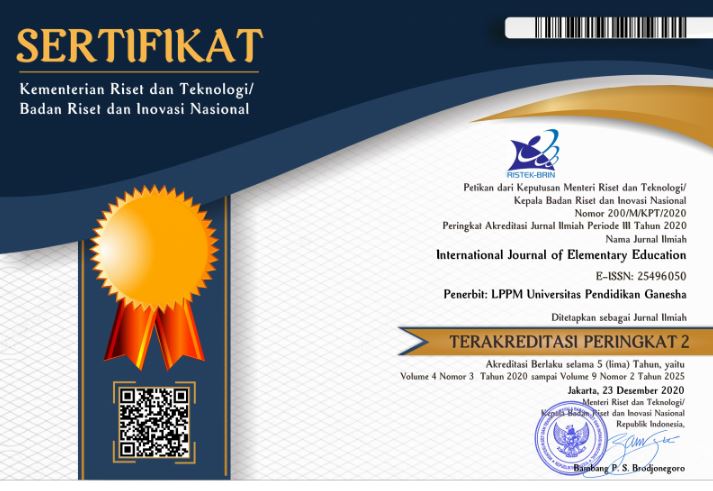Improving Learning Outcomes of 2nd Grade Students through Video-Based Learning Media
DOI:
https://doi.org/10.23887/ijee.v4i3.28686Keywords:
research and development, video-based learning mediaAbstract
The low student learning outcomes due to the lack of learning media make it difficult for students to understand learning material. This study aimed to develop video-based learning media about the properties of objects around us in theme 2, sub-themes 1 grade 2nd. This study used a Research and Development (R&D) type of research with a 4D development model consisting of four stages, namely define, design, develop, and disseminate. The methods used in collecting data were observation, interviews, and questionnaires. Data were analyzed using descriptive statistics. The development of video media is valid with: (a) the results of the reviews by linguists get very good qualifications, (b) the results of the reviews of instructional media experts get very good qualifications, (c) the results of the reviews of subject matter experts get very good qualifications, (d) the results of the trial individuals get very good qualifications, (e) the results of small group trials get very good qualifications, and (e) the results of field trials get very good qualifications. So, this study showed that the validity of video-based learning media on qualifications is very good and can improve student learning outcomes.
References
Aditya, A. (2017). Penggunaan Media Pembelajaran Audio Visual Untuk Meningkatkan Hasil Belajar IPS Pada Siswa Kelas IV SD. Mimbar Sekolah Dasar, 4(1). Retrieved from http://ejournal.upi.edu/index.php/mimbar/article/download/5227/pdf
Anika, & Fajar. (2020). Efektivitas Model Pembelajaran Kooperatif Tipe Make-A Match Dalam Meningkatkan Kompetensi Sikap Siswa dan Kompetensi Pengetahuan Siswa Pada Pelajaran IPS. Jurnal Ilmiah Sekolah Dasar, 4(1), 80–85.
Arsyad, A. (2019). Media Pembelajaran. Jakarta: PT. Raja Grafindo Persada.
Astini, Nurhasanah, & Nupus. (2019). Alat Permainan Esdukasi Berbasis Lingkungan untuk Pembelajaran Saintifik Tema Lingkungan bagi Guru Paud Korban Gempa. Jurnal Pendidikan Anak, 8(1), 1–6. Retrieved from https://journal.uny.ac.id/index.php/jpa/article/view/26760
Donas Ahmad Najib &Elhefni. (2016). Pengaruh Penerapan Pembelajaran Bermakna (Meaningfull Learning) Pada Pembelajaran Tematik IPS Terpadu Terhadap Hasil Belajar Siswa Kelas III di MI Ahliyah IV Palembang. JIP: Jurnal Ilmiah PGMI, 2(1), 19–28. Retrieved from http://jurnal.radenfatah.ac.id/index.php/jip/article/view/1063
Fadhli, M. (2015). Pengembangan Media Pembelajaran Berbasis Video Kelas IV Sekolah Dasar. Jurnal Dimensi Pendidikan Dan Pembelajaran, 3(1), 24–29. https://doi.org/http://dx.doi.org/10.24269/dpp.v3i1.157
Irwandi. (2020). Penggunaan Media Audio Visual Dalam Peningkatan Hasil Belajar Materi Rukun Iman Pada Siswa Kelas I SD Negeri 49 Kota Banda Aceh. Pionir Jurnal Pendidikan, 9(1), 25–44.
Jailani. (2017). Penggunaan Peta Konsep Untuk Belajar Bermakna Dan Peningkatan Pemahaman Siswa dalam Pembelajaran Biologi. Jurnal Biology Education, 6(1), 30–40. https://doi.org/10.1017/CBO9781107415324.004
Naharir, Dantes, & Kusmariyatni. (2018). Pengaruh Model Pembelajaran Course Review Horay Berbantuan Media Video Pembelajaran Terhadap Hasil Belajar Matematika Siswa Kelas V Semester II SD Gugus VI Kecamatan Sukasada Kabupaten Buleleng Tahun Pelajaran 2017/2018. Mimbar PGSD Undiksha, 6(1), 15–21. Retrieved from https://ejournal.undiksha.ac.id/index.php/JJPGSD/article/view/16975/10172. 15-21
Nida, & Dkk. (2020). Pengembangan Media Kartu Bergambar Berorientasi Pendidikan Karakter Pada Mata Pelajaran Bahasa Bali. Jurnal EDUTECH Universitas Pendidikan Ganesha., 8(1), 16–31. Retrieved from https://ejournal.undiksha.ac.id/index.php/JEU/article/view/25393/15846
Novita, Sukmanasa, & Pratama. (2019). Penggunaan Media Pembelajaran Video Terhadap Hasil Belajar Siswa SD. Indonesian Journal of Primary Education, 3(2), 64–72. Retrieved from https://ejournal.upi.edu/index.php/IJPE/article/view/22103
Oktapiani, Sumardi, & Giyartini. (n.d.). Pengembangan Media Ular Tangga tentang Lahirnya Pancasila untuk IPS Kelas V SD. 2020, 4(1), 56–68. Retrieved from https://ejournal.upi.edu/index.php/IJPE/article/view/24185/12108.
Purwanti, B. (2015). Pengembangan Media Video Pembelajaran Matematika dengan Model Assure. Jurnal Kebijakan Dan Pengembangan Pendidikan, 3(1), 42–47. https://doi.org/https://doi.org/10.22219/jkpp.v3i1.2194
Qondias, & Dkk. (2016). Pengembangan Media Pembelajaran Tematik Berbasis Mind Mapping SD Kabupaten Ngada Flores. Jurnal Pendidikan Indonesia, 5(2), 176--182. Retrieved from https://ejournal.undiksha.ac.id/index.php/JPI/about
Sudarma, & Dkk. (2015). Desain Pesan Kajian Analitis Desain Visual Teks dan Image. Yogyakarta: Graha Ilmu.
Sugiyono. (2016). Metodologi Pendidikan. Bandung: Alfabeta.
Sukmanasa, Windiyani, & Novita. (2017). Pengembangan Media Pembelajaran Komik Digital Pada Mata Pelajaran Ilmu Pengetahuan Sosial Bagi Siswa Kelas V Sekolah Dasar Di Kota Bogor. Jurnal Pendidikan Sekolah Dasar, 3(2). https://doi.org/https://doi.org/10.30870/jpsd.v3i2.2138
Suyanto, S. (2018). The Implementation Of The Scientific Approach Through 5ms Of The Revised Curriculum 2013 In Indonesia. Cakrawala Pendidikan, 37(1), 22–29. Retrieved from https://journal.uny.ac.id/index.php/cp/article/view/18719/pdf
Taqiya, Nuroso, & Reffiane. (2019). Pengaruh Model Pembelajaran Terpadu Tipe Connected Berbantu Media Video Animasi. Mimbar PGSD Undiksha, 7(3), 289–295. Retrieved from https://ejournal.undiksha.ac.id/index.php/JJPGSD/article/view/19492/11545.
Tegeh, Simamora, & Dwipayana. (2019). Pengembangan Media Video Pembelajaran Dengan Model Pengembangan 4D Pada Mata Pelajaran Agama Hindu. Mimbar Ilmub, 24(2), 158–166. Retrieved from https://ejournal.undiksha.ac.id/index.php/MI/article/view/21262/13262
Upayanto, I. D. (2017). Pelaksanaan Proses Pembelajaran Kurikulum 2013 SD Negeri 4 Krandegan. Jurnal Pendidikan Guru Sekolah Dasar, 6(1), 40–52. Retrieved from http://journal.student.uny.ac.id/ojs/index.php/pgsd/article/view/6605/6371
Widjiningsih, Sugiyono, & Gafur. (2014). Efektivitas Dan Efisiensi Pembelajaran Teknik Draping Berbantuan Video Di Perguruan Tinggi. Cakrawala Pendidikan, 1(33), 62–70. Retrieved from https://journal.uny.ac.id/index.php/cp/article/view/1862/pdf33
Wulandari, & Dkk. (2020). Pengembangan Pembelajaran Blended Pada Mata Kuliah Ahara Yoga Semester II di IHDN Denpasar. Jurnal Edutech Undiksha, 8(1), 1–15. https://doi.org/http://dx.doi.org/10.23887/jeu.v8i1.26459
Downloads
Published
How to Cite
Issue
Section
License
Authors who publish with the International Journal of Elementary Education agree to the following terms:
- Authors retain copyright and grant the journal the right of first publication with the work simultaneously licensed under a Creative Commons Attribution License (CC BY-SA 4.0) that allows others to share the work with an acknowledgment of the work's authorship and initial publication in this journal.
- Authors are able to enter into separate, additional contractual arrangements for the non-exclusive distribution of the journal's published version of the work (e.g., post it to an institutional repository or publish it in a book), with an acknowledgment of its initial publication in this journal.
- Authors are permitted and encouraged to post their work online (e.g., in institutional repositories or on their website) prior to and during the submission process, as it can lead to productive exchanges, as well as earlier and greater citation of published work. (See The Effect of Open Access)









